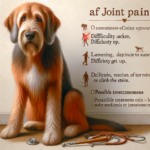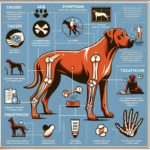Otterhound Joint Pain: Causes, Symptoms, Prevention, and Treatment

Introduction
Overview of Otterhound: The Otterhound is a rare and ancient breed, originally developed in England for hunting otters. With a history dating back to the medieval period, this breed is known for its keen sense of smell, webbed feet, and dense, water-resistant coat. Otterhounds are large, friendly, and energetic dogs, often characterized by their shaggy appearance and distinctive, melodious bay.
General Health Concerns: Like many large breeds, Otterhounds are prone to certain health issues, including hip dysplasia, elbow dysplasia, and bloat. These conditions can significantly impact their quality of life if not managed properly. Among these, joint pain is a particularly pressing concern due to the breed’s size and activity level.
Importance of Joint Health in Otterhounds: Joint health is crucial for Otterhounds, given their active nature and historical role as working dogs. Healthy joints are essential for maintaining their mobility, comfort, and overall well-being. Addressing joint health proactively can help prevent debilitating conditions that could otherwise limit their ability to enjoy an active lifestyle.
Breed-Specific Joint Pain Risks
Genetic Predisposition
Otterhounds have a genetic predisposition to several joint-related issues. Hip dysplasia, a condition where the hip joint doesn’t fit properly into the hip socket, is common in this breed. Elbow dysplasia, which involves abnormal development of the elbow joint, can also occur. Both conditions can lead to arthritis and chronic pain if not addressed early.
Age-Related Risks
As Otterhounds age, the risk of developing joint pain increases. Typically, signs of joint issues may start to appear in middle age, around 5 to 7 years old. However, some dogs may show symptoms earlier, especially if they have a genetic predisposition or have experienced joint injuries.
Activity Level and Joint Stress
Otterhounds are known for their high energy levels and love for outdoor activities. While regular exercise is essential for their overall health, excessive or high-impact activities can put additional stress on their joints. Activities like running on hard surfaces, jumping, or intense play can exacerbate joint issues, especially in dogs with a predisposition to joint problems.
Common Symptoms of Joint Pain in Otterhounds
General Symptoms
- Limping: One of the most noticeable signs of joint pain is limping or favoring one leg over another.
- Stiffness: Stiffness, especially after rest or in the morning, can indicate joint pain.
- Reluctance to Move: A dog that is hesitant to climb stairs, jump, or go for walks may be experiencing joint discomfort.
- Swelling: Swelling around the joints can be a sign of inflammation and pain.
- Behavioral Changes: Irritability, lethargy, or changes in appetite can also be indicators of pain.
Breed-Specific Symptoms
In Otterhounds, joint pain may manifest as a reluctance to engage in activities they once enjoyed, such as swimming or long walks. Given their size, you might also notice a more pronounced limp or difficulty getting up from a lying position.
When to Consult a Vet
If you observe any of the above symptoms, it’s crucial to consult a veterinarian. Early intervention can prevent further deterioration and improve your dog’s quality of life. Persistent limping, noticeable pain, or any sudden changes in behavior should prompt an immediate veterinary visit.
Preventive Measures for Joint Health
Exercise Recommendations
Regular, moderate exercise is key to maintaining joint health in Otterhounds. Activities like swimming, which is low-impact and easy on the joints, are ideal. Avoid high-impact exercises like running on hard surfaces or excessive jumping. Instead, opt for controlled walks and play sessions on soft ground.
Dietary Suggestions
A balanced diet rich in essential nutrients can support joint health. Look for dog foods that contain glucosamine and chondroitin, which help maintain cartilage health. Omega-3 fatty acids, found in fish oil supplements, can reduce inflammation and support joint function. Always consult your vet before adding supplements to your dog’s diet.
Weight Management
Maintaining a healthy weight is crucial for reducing joint stress. Excess weight can exacerbate joint issues and lead to more severe pain. Monitor your Otterhound’s weight regularly and adjust their diet and exercise routine as needed to keep them at an optimal weight.
Early Screening and Monitoring
Regular veterinary check-ups are essential for early detection of joint issues. Screening tests like X-rays can help identify problems before they become severe. Discuss with your vet about the best times to start screening, especially if your dog has a family history of joint problems.
Treatment Options for Joint Pain
Non-Surgical Treatments
Non-surgical treatments can be effective in managing joint pain. These include:
- Medications: Anti-inflammatory drugs and pain relievers can help manage pain and reduce inflammation.
- Physical Therapy: Exercises designed to strengthen the muscles around the joints can improve mobility and reduce pain.
- Lifestyle Adjustments: Modifying your dog’s activity level and providing a comfortable living environment can also help manage pain.
Surgical Options
In severe cases, surgical intervention may be necessary. Common surgeries for joint issues in Otterhounds include:
- Hip Replacement: This surgery involves replacing the damaged hip joint with an artificial one.
- Arthroscopy: A minimally invasive procedure used to diagnose and treat joint problems.
- Osteotomy: A surgical procedure that involves cutting and realigning bones to relieve joint stress.
Alternative Therapies
Alternative therapies can complement traditional treatments and provide additional relief. These include:
- Acupuncture: This ancient practice can help reduce pain and improve joint function.
- Hydrotherapy: Water-based exercises can strengthen muscles without putting stress on the joints.
- Massage: Regular massage can improve circulation and reduce muscle tension around the joints.
Lifestyle and Management Tips
Daily Care Routine
A consistent daily care routine can help manage joint pain. This might include gentle morning walks, followed by a session of physical therapy exercises. Ensure your Otterhound has a comfortable place to rest, and avoid activities that could strain their joints.
Modifying the Home Environment
Making your home more joint-friendly can significantly improve your dog’s comfort. Consider adding ramps to help them navigate stairs, and provide orthopedic beds that offer better support for their joints. Non-slip mats can also prevent falls and reduce joint strain.
Long-Term Management
Long-term management of joint pain involves regular veterinary check-ups, consistent exercise, and a balanced diet. Monitoring your dog’s weight and adjusting their care routine as needed can help keep them active and happy despite joint issues.
FAQs About Otterhounds and Joint Pain
What are the early signs of joint pain in Otterhounds?
Early signs include limping, stiffness, reluctance to move, and behavioral changes such as irritability or lethargy.
Can joint pain in Otterhounds be prevented?
While genetic predispositions can’t be changed, maintaining a healthy weight, providing a balanced diet, and ensuring regular, low-impact exercise can help prevent or delay the onset of joint pain.
Are there specific foods that can help with joint health?
Yes, foods rich in glucosamine, chondroitin, and omega-3 fatty acids can support joint health. Consult your vet for specific dietary recommendations.
When should I start screening my Otterhound for joint issues?
It’s advisable to start screening for joint issues around middle age, or earlier if there’s a family history of joint problems. Regular veterinary check-ups can help catch issues early.
Conclusion
Joint health is a critical aspect of caring for an Otterhound. By understanding the breed-specific risks, recognizing early symptoms, and taking preventive measures, you can help ensure your dog remains active and comfortable throughout their life. Regular veterinary consultations and a proactive approach to joint health can make a significant difference in your Otterhound’s quality of life.
Remember, early intervention is key. If you notice any signs of joint pain, consult your veterinarian promptly to develop an effective treatment plan tailored to your dog’s needs.




